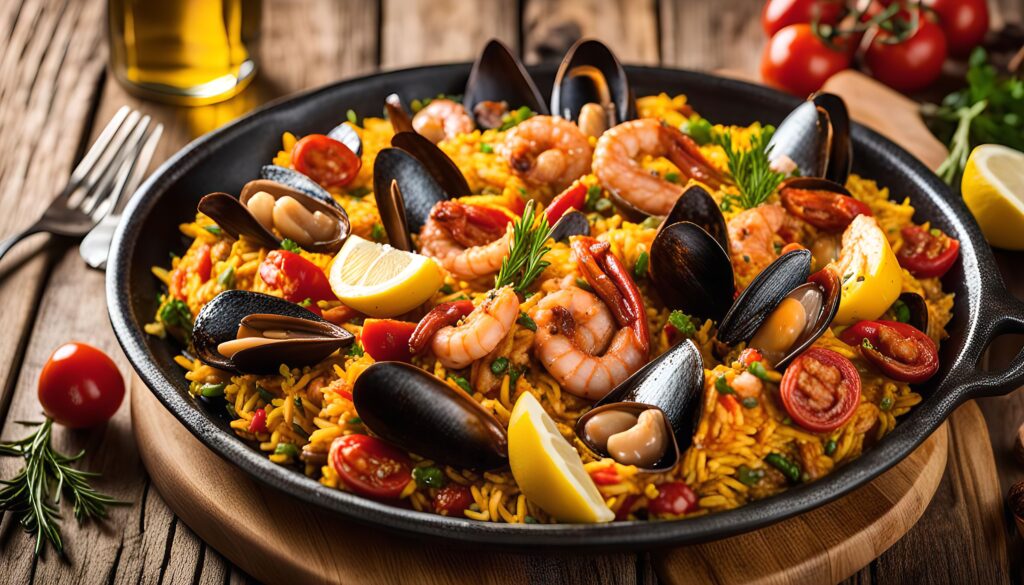
Spanish Seafood Paella: A Taste of the Mediterranean
Spanish Seafood Paella is a vibrant and flavorful dish that hails from the coastal regions of Spain. This iconic dish combines saffron-infused rice with a medley of fresh seafood, creating a meal that is as visually stunning as it is delicious. Chef Abdul, celebrated for his expertise in Mediterranean cuisine, shares his recipe and tips for mastering the art of Spanish Seafood Paella. Whether you’re hosting a dinner party or looking to elevate your weeknight meals, this dish is sure to impress.
The History of Paella
Originating in Valencia, paella was traditionally cooked over an open fire in a wide, shallow pan. While there are many variations of paella—including chicken, vegetarian, and mixed versions—seafood paella is a favorite for its rich flavors and connection to Spain’s coastal heritage.
“Seafood Paella is a celebration of Spain’s culinary diversity, combining fresh ingredients with traditional techniques to create a dish that’s both comforting and elegant,” says Chef Abdul.
Ingredients
- 2 cups Bomba or Arborio rice
- 1/2 teaspoon saffron threads
- 4 cups seafood stock (warm)
- 2 tablespoons olive oil
- 1 medium onion, finely chopped
- 3 garlic cloves, minced
- 1 red bell pepper, diced
- 1 cup diced tomatoes (fresh or canned)
- 1 teaspoon smoked paprika
- 1/2 cup dry white wine
- 8 large shrimp (peeled and deveined, tails on)
- 8 mussels (cleaned)
- 8 clams (cleaned)
- 1/2 cup frozen peas (optional)
- 1/4 cup chopped parsley
- Lemon wedges for garnish
- Salt and pepper to taste
Method to Make Spanish Seafood Paella
- Prepare the Saffron Stock:
- In a small bowl, combine the saffron threads with 1/4 cup of warm seafood stock. Let it steep for 5-10 minutes.
- Sauté the Aromatics:
- Heat olive oil in a large paella pan or wide, shallow skillet over medium heat. Add the onion, garlic, and bell pepper. Sauté until softened.
- Cook the Base:
- Stir in the diced tomatoes and smoked paprika. Cook for 3-4 minutes until the mixture thickens slightly.
- Add the Rice and Wine:
- Stir in the rice, ensuring it is evenly coated with the tomato mixture. Add the white wine and cook until absorbed.
- Incorporate the Stock:
- Add the saffron-infused stock along with the remaining seafood stock. Gently stir to distribute the liquid, then stop stirring to allow the rice to cook evenly.
- Arrange the Seafood:
- After 10 minutes of cooking, arrange the shrimp, mussels, and clams on top of the rice. Cover the pan with foil and continue cooking for another 10-15 minutes, or until the seafood is cooked and the rice has absorbed the liquid.
- Add the Finishing Touches:
- Sprinkle the peas and parsley over the top. Cover again for 2-3 minutes to warm through.
- Serve:
- Remove the pan from heat and let it rest for 5 minutes. Serve directly from the pan with lemon wedges on the side.
Tips for Success
- Choose the Right Pan: A wide, shallow paella pan ensures even cooking and the formation of socarrat (crispy rice at the bottom).
- High-Quality Saffron: Authentic saffron adds the signature color and flavor to paella.
- Don’t Over-Stir: Stirring disrupts the rice’s cooking process and prevents the formation of socarrat.
Pairings for Spanish Seafood Paella
- Salad: Pair with a light Mediterranean salad with olives, cucumbers, and feta.
- Bread: Serve with crusty bread to soak up the flavorful juices.
- Wine: A crisp white wine, such as Albariño or Verdejo, complements the seafood and saffron.
Conclusion
Spanish Seafood Paella is a culinary masterpiece that brings the flavors of the Mediterranean to your table. Chef Abdul’s recipe ensures a perfectly cooked paella with tender seafood, aromatic saffron, and rich, smoky flavors. Whether you’re a seasoned cook or a beginner, this dish is a showstopper that will transport you to the sunny coasts of Spain.
As Chef Abdul puts it, “A great paella is more than just a dish—it’s an experience that brings people together to savour the best of Spain’s culinary heritage.”

